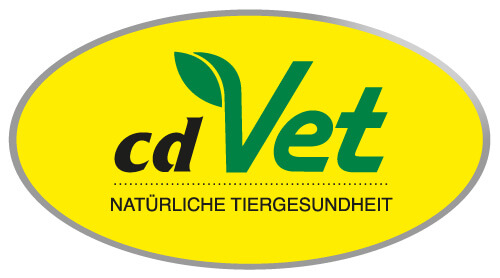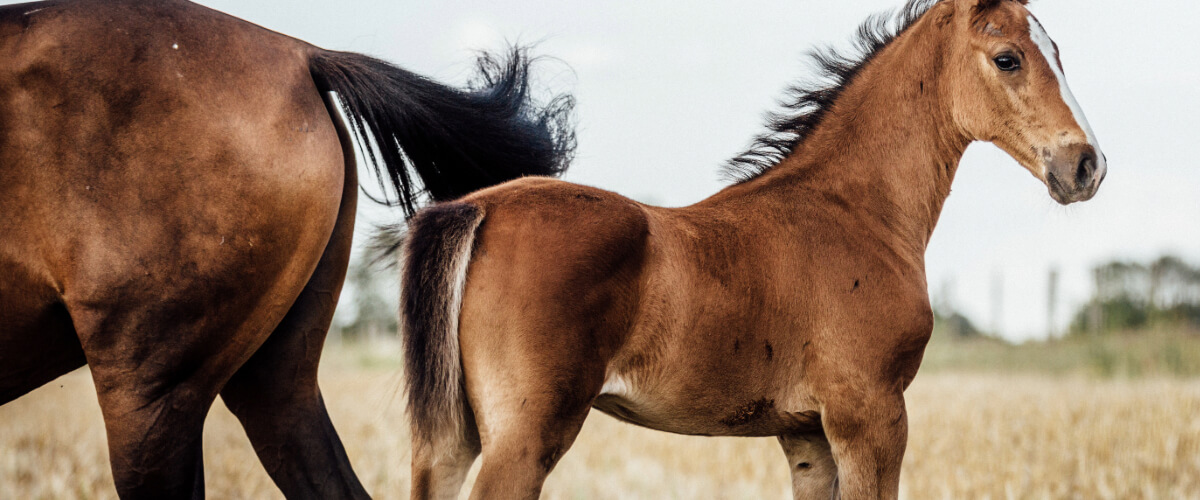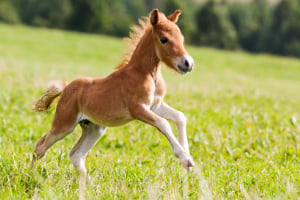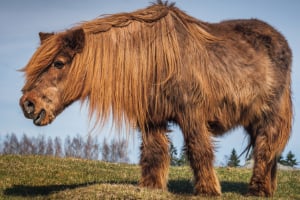Vom Fohlen bis zum Senior
In jedem Lebensabschnitt hat ein Pferd besondere Ansprüche, die erfüllt werden müssen, um das Wohlbefinden des Pferdes zu unterstützen. Die passende Ernährung ist ein wichtiger Punkt für die Gewährleistung der Gesundheit des Tieres. Egal ob Fohlen, Zuchtstuten oder Senioren - cdVet bietet für jedes Pferd oder Pony das richtige Produkt für eine bedarfsgerechte Ernährung.
- Dogs
- Cats
- Horses
- Small Animals
- Agriculture
- Household
- Promotions and highlights
- Seminars & Training
- ProBreeder
- Exclusive Brands
- Service
Filter products
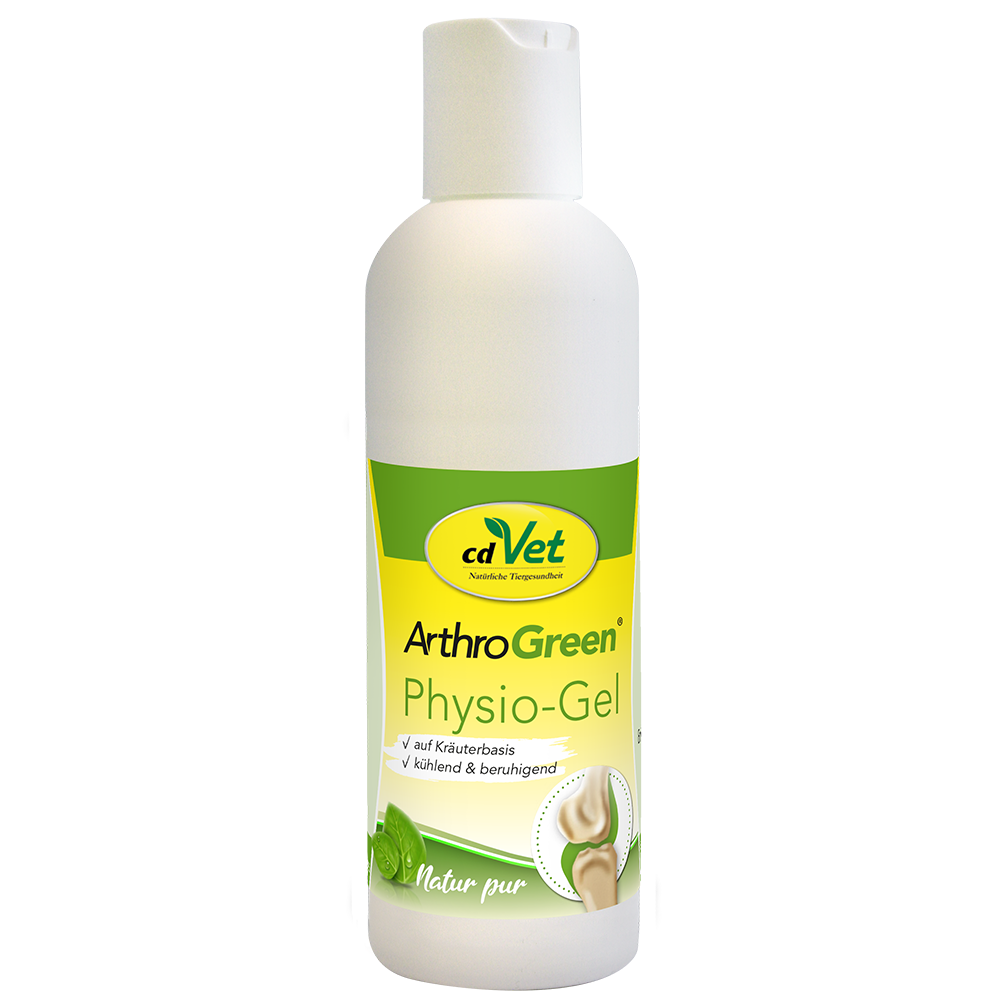
Care product for animalsNatural care product based on herbs for supportive care in the joint area, cooling and soothingWhether it is the rampaging and playing young dog that falls over its own paws every now and then, or the young foal that cuts a caper in the paddock, or the elderly senior who can‘t quite get out of his basket or box in the morning. The joints have to do a lot, and every now and then they also have a bad day, and need a little bit of our support. Then how about a supportive, soothing care from the outside. ArthroGreen Joint Gel is easy to apply, and a boon for tendons, ligaments, and joints.Composition: aqua, natural emulsifier, peppermint oil, xanthan gum, marigold oil, eucalyptus oil, St. John‘s wort oil, jojoba oil, rosemary oil, green tea extract, arnica flower extract, gum arabicHow to use: rub thinly and evenly into the affected areas of the skin 2 x daily. Application duration: at least 3-8 days.Not suitable for cats !Contains 1,8-Cineole, L-menthan-3-one, Dipentene, Pin-2(3)-ene and d-Carvone. May produce an allergic reaction.
Content: 0.1 Liter (€159.50 / 1 Liter)

Complementary feed (powder, coarse structure) for maresFor additional feeding in the event of fertility problems and for nutrition-related support of the uterine conditionEquiGreen BroodmaresMix has been developed to nutritionally support the mare‘s fertility. This special blend can promote blood circulation in the uterus, strengthen its muscles and thus facilitate the birth process and subsequent regeneration of the mare. EquiGreen BroodmareMix compensates for nutritional imbalances in the last weeks of gestation and in the first lactation phase and activates the metabolism.Herbs & FertilityThe minerals, trace elements and vitamins contained in herbs can compensate for the lack of herbs in today‘s meadows and thus provide a wide range of support during birthing:Fertility-supporting herbs stimulate and regulate the hormone balance and thus also ovulation (or the production of the corpus luteum for implantation of the egg).Phytohormones strengthen the uterine tissue and can support the birth and foaling process.The physiological detachment of the placenta is naturally supported.Vitamins & FertilityThe feeding of a not in foal mare should be adapted to her actual energy and micronutrient requirements:Special features, such as a lactating mare, must be taken into account.Nutrient deficiencies should be compensated for before the mating, in order to promote the probability of a good intake and healthy foal development.Vitamin A, is the `fertility vitamin´ - a deficiency can lead to loss of fertility or malformations, even death of the embryo.An additional supply of ß-carotene before conception and during gestation is therefore recommended.Composition: carrots, ladys mantle herb, birch leaves, stinging nettle herb, chamomile blossoms, yarrow herb.Analytical constituents: crude protein 11.7%, crude fat 3.5%, crude fiber 11.6%, crude ash 7.3%, calcium 0.85%, phosphorus 0.34%, sodium 0.26%.Feeding recommendation: Add 15-20 g/animal to the feed daily. 1 tbsp. corresponds to approx. 4 g. Fertility promotion: 3-4 weeks before covering and a further 3 weeks during existing gestation. Gestating mares: 3 weeks before the expected date of foaling and 3 weeks after the foaling.Store it cool and dry.
Content: 0.8 Kilogramm (€47.44 / 1 Kilogramm)
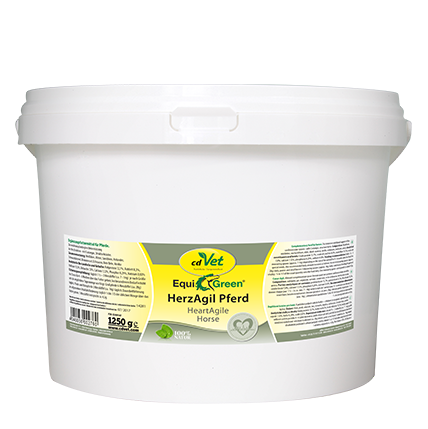
Complementary feed (coarse structure) for horsesFor the nutrition-related support of the cardiac functionEquiGreen HeartAgile contains exquisite and balanced herbs that provide the animal with important bioflavones and vitamins. The sophisticated herbal blend nutritionally supports nutrient-related the cardiovascular system of the animal.Composition: mistletoe herb, elderberries, purple corneflower herb, hawthorn berries, sea buckthorn berries, beetroot, stinging nettle herb (ground), black cumin seeds, hawthorn leaves with blossoms, mountain arnica blossoms.Analytical constituents: crude protein 12.7%, crude fat 8.3%, crude fiber 15.5%, crude ash 7.8%, calcium 1.12%, phosphorus 0.29%, sodium 0.03%.Feeding recommendation: Add 2.4 g/100 kg body weight to the feed daily for 4-6 weeks. As required, the recommended daily amount can be increased. 1 tsp. corresponds to approx. 1.2 g / 1 tbsp. corresponds to approx. 3.6 g.
Content: 1.25 Kilogramm (€102.36 / 1 Kilogramm)
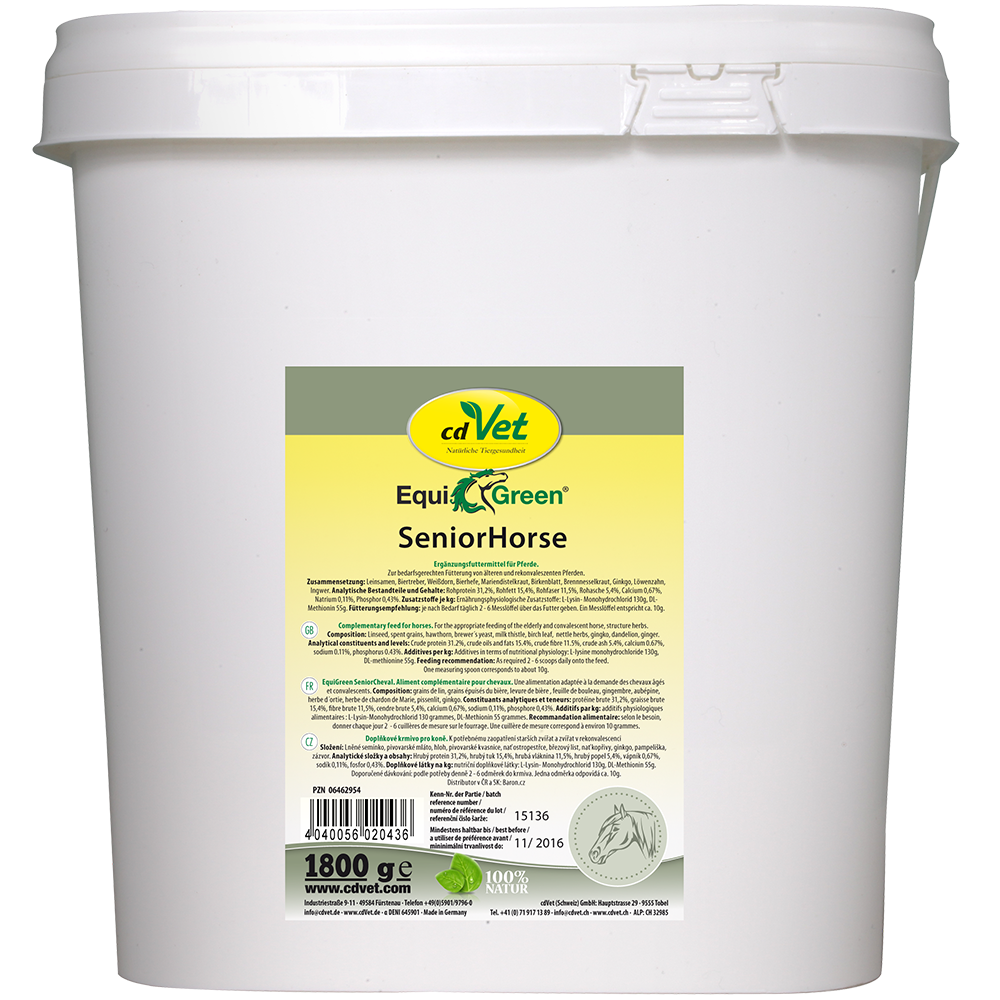
Complementary feed for horsesFor the nutrition-related support at general weakness and in old age, structural herbsEspecially in older horses, the physiological body functions are often weakened. By an optimal supply of vitamins, trace elements, amino acids and selected herbs nutritional deficiencies can be compensated. A balanced diet with optimal basic nutrients, appropriate concentrate intake and the best complementary feed is just as important as the best environmental conditions, as well as a personalized training program.Tip of an expert: As regards the additional micronutrient and mineral supply EquiGreen MicroMineral is recommended.The performance of the horse depends on many factors:- healthy active and passive movement system- healthy internal organs- intact respiratory and circulatory system- functioning digestive tract- balanced temperamentComposition: linseed, brewers‘ grains, hawthorn, brewers´ yeast, milk thistle herb, birch leaf, stinging nettle herb, gingko leaves, dandelion herb, ginger, dandelion root.Additives per kg: Nutritional additives: L-lysine monohydrochloride 102 g, L-methionine (3c305) 55 g.Analytical constituents: crude protein 31.2%, crude fat 15.4%, crude fiber 11.5%, crude ash 5.4%, calcium 0.67%, sodium 0.11%, phosphorus 0.43%.Feeding recommendation: give 10 g/100 kg body weight daily to the feed as required. 1 tbsp. corresponds to approx. 5.5 g.
Content: 1.8 Kilogramm (€28.86 / 1 Kilogramm)
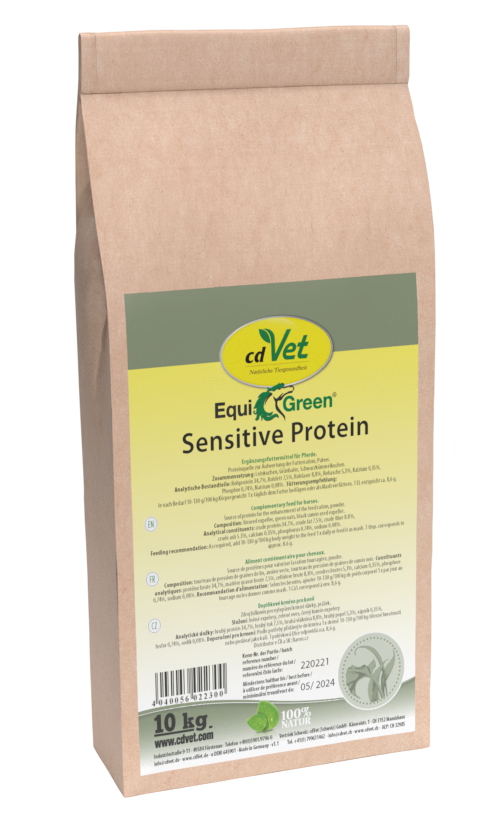
Complementary feed for horsesSource of protein for the enhancement of the feed ration, powderNot all hay is the sameIn some years, hay quality often presents horse owners with a major challenge, and they do not always have the opportunity to change anything themselves. Especially in 2022, the hay quality in the analyses shows low values in the area of digestible crude protein and, in comparison, very high sugar values.Proteins are the building materials of the body. They are needed for daily renewal processes, muscle development and maintenance, and cell regeneration. Thus, a low-protein hay is a special challenge for all horses in active training, in the use of mating, in growth, for horses with an increased protein requirement due to muscle diseases, and for seniors.The high sugar levels, in turn, pose an increased risk for all metabolically sensitive horses. EquiGreen Sensitive Protein can have a positive influence on the insulin sensitivity of the cells and the blood sugar level. Valuable protein sources in the form of gently processed oil press expeller supply your horses with essential amino acids and provide important energy for the supply of muscles and body. In winter, EquiGreen Sensitive Protein can help to maintain the muscles and provide sufficient building materials for the constant renewal processes.Composition: linseed expeller, green oats, black cumin seed expeller.Analytical constituents: crude protein 34.7%, crude fat 7.5%, crude fiber 8.8%, crude ash 5.3%, calcium 0.35%, phosphorus 0.74%, sodium 0.08%.Feeding recommendation: As required, add 10-130 g/100 kg body weight to the feed 1 x daily or feed it as mash. 1 tbsp. corresponds to approx. 8.6 g.
Content: 10 Kilogramm (€5.00 / 1 Kilogramm)
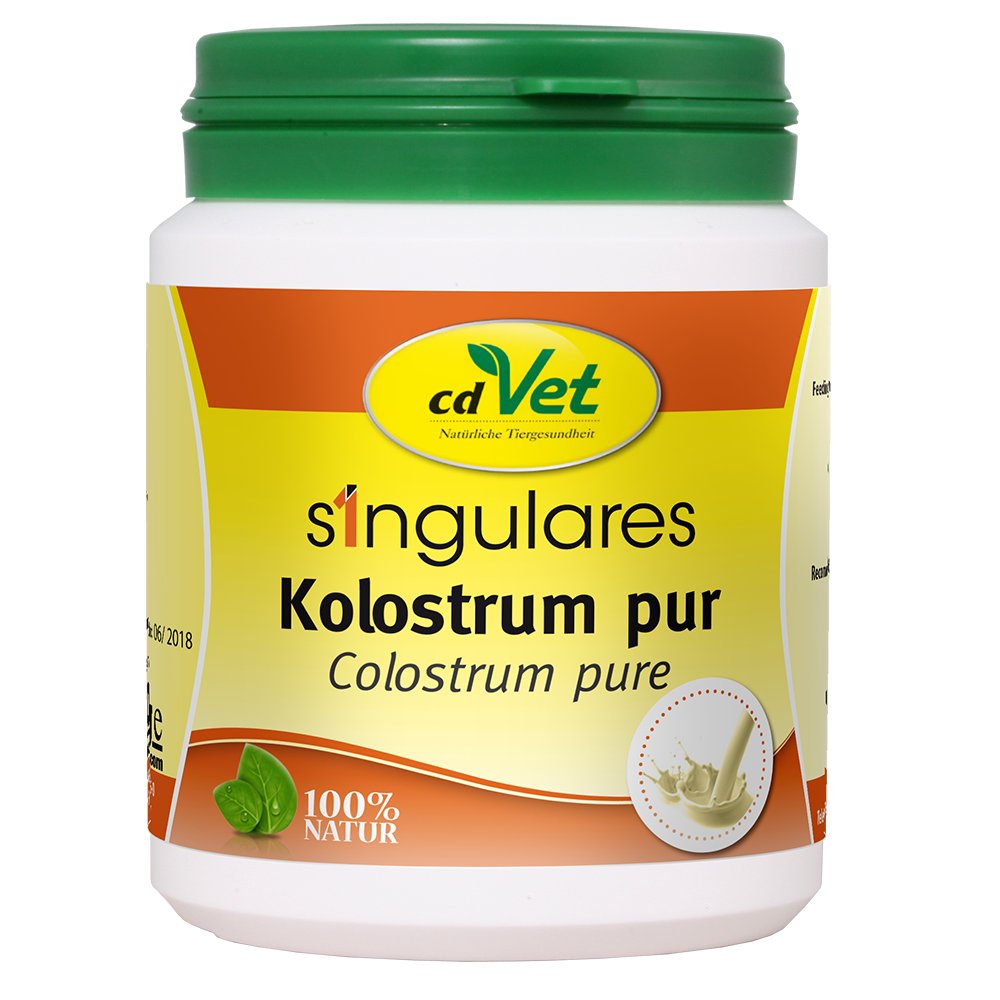
Feed material For the nutritional-related strengthening of the immune system and organism - immunoglobulins, vitamins, minerals, and amino acidsColostrum, also called foremilk or beestings mild, is one of the oldest and most extraordinary foods found in nature. Colostrum is unique - in addition to vitamins, minerals, trace elements, essential and non-essential amino acids, colostrum provides natural immune and growth factors in a unique variety and concentration not found in any other plant or chemical product!Singulares Colostrum pure is particularly gently dried. We have deliberately chosen bovine colostrum because cows have relatively high surplus quantities during the first milkings (in contrast to sheep and goats), so that sufficient colostrum is also available for the calf.Singulares Colostrum pure has proven itself:for the natural strengthening of the entire immune systemconcentrated nutrient cocktail to strengthen malnourished, weak animalsto strengthen mother animals, before and after birthas a complement to maternal milkto strengthen the vital functions of older and young animalsExpert Tip: For orphaned puppies and kittens we recommend cdVet Puppy Milk and feliTATZ Kitten Milk, respectively, as a replacement milk.What amount of colostrum should be fed?The condition of the newborn is decisive for the feeding quantity. If the young animal is not getting enough, it signals this by restlessness and/or audible crying. Then check whether the solution has not been diluted too much. If the young animal reacts with digestive disorders, the concentration will be reduced.Composition: 100% bovine colostrum.Analytical constituents and levels: crude protein 45%.Feeding recommendation for adult/young animals: Dog/cat: 1 g/10 kg body weight per day. Horse/pony/donkey: 5 g/100 kg body weight per day. Pigeon: 2 g/kg feed or 2 g/L drinking water. 1 heaped tsp. corresponds to approx. 4 g.Feeding recommendation in case of loss of the mother : Mix colostrum with 50°C warm water without lumps, or shake well in a bottle, feed at body temperature (37°C). Puppy/kitten: mix 10 g with 30 ml water. Lamb/cria/piglet: mix 75 g with 225 ml water, feed the finished mixture within 5 hours. Foal: mix 300 g with 900 ml water. The amount of liquid should be 3-5 L in the first 24 hours. 1 heaped tbsp. corresponds to approx. 16 g.The specified feeding quantities are only guidelines. However, those must be adapted to the individual needs and condition of your young animal. The feeding quantity can be increased for strong young animals. Colostrum should be given as soon as possible after birth (ideally in the first 2 hours), then every 1-2 hours and supplemented with a good replacement milk within 24 hours!
Content: 0.1 Kilogramm (€379.50 / 1 Kilogramm)
Yes, foals can drink water while nursing. Although mother's milk is the main part of their diet, foals begin to show interest in and consume water from an early age. The mother mare will often teach her foals how to drink from a water bowl. It is important to ensure that fresh, clean water is constantly available to help foals stay hydrated, especially as they begin to eat more solid feed. Water intake is a natural part of development and contributes to foals' health and well-being.
Foals usually start eating solid food, in addition to their mother's milk, from the second month of life. However, this timing can vary individually, depending on the foal's development and other factors. The transition to solid food is gradual, starting with small amounts of easily digestible food, such as specially formulated foal food or porridge. The mother mare often helps by showing the foal how to eat solid food. It is important to carefully monitor foals during this transition and ensure that their diet is optimally tailored to their needs.
The length of the nursing period, i.e. how long a foal drinks mother's milk, varies but is generally about six months to a year. However, most foals begin eating solid food from just a few weeks of age while continuing to drink mother's milk. The time of weaning, i.e. separation from the mother, is often in the range of 4 to 6 months, but individual circumstances, the foal's development and specific breeding goals can affect this time period. A balanced diet and a gradual transition to solid food play an important role in ensuring that the foal is adequately cared for during the weaning process.
The optimal time for weaning, i.e. separating the foal from the mother mare, varies and depends on various factors. However, weaning usually takes place at around 4 to 6 months of age. This time allows the foal to benefit sufficiently from the mother's milk while learning social skills from the mother. Gradual weaning can minimize stress for both animals. It is important to consider individual circumstances, the well-being of the mare and foal, and the intended use when determining the best time for weaning.
A mare's sexual maturity usually occurs around 18 months of age, but can vary individually. This timing is often associated with the onset of estrus, the mare's natural reproductive cycle. It is important to note that sexual maturity does not equate to optimal breeding maturity. Many experts recommend waiting to breed until the mare is physically and mentally mature, which usually occurs around three years of age. Individual assessment and veterinary advice are crucial in making the best decisions for the mare's health and well-being.
